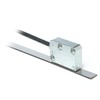| Product type | Resolution, Repeat accuracy | Product group, Accuracy class | Supply, Interface | Scale |
|---|
| | dependent on downstream electronic unit | MagLine Micro,
max. 10 µm | only in connection with MA100/2 | MB100/1 |
| | 0.2 µm | MagLine Micro,
max. 10 µm | 4.75 - 6 V, 6.5 - 30 V, LD, ABI, ABR | MB100/1 |
| | dependent on downstream electronic unit | MagLine Micro,
max. 10 µm
MagLine Roto,
dependent on downstream electronic unit | 5 V, 10,5 - 30 V, 1 Vss | MB100/1
MBR100 |
| | dependent on downstream electronic unit | MagLine Micro,
max. 10 µm | 5 V, 1 Vss | MB100/1 |
| | 0.1 µm, ±1 µm | MagLine Micro,
max. 8 µm | 5 V, LD, 1Vss, ABR | MB100/1 |
| | max. 1 µm (SSI), ± 2 µm | MagLine Micro,
max. 10 µm | 4,5 - 30 V, SSI, 1 Vss, RS485, DRIVE-CliQ | MBA111 |
| | 1 µm, ±1 µm | MagLine Micro |
LD, 1 Vss, RS485, SSI, BiSS C, IO- Link | MBA213 |
| | 1 µm, ±1 µm | MagLine Micro,
max. 10 µm | LD, 1 Vss, SSI, BiSS C, IO- Link | MBA213 |
| | dependent on downstream electronic unit | MagLine Basic,
max. 50 µm | only in connection with MA502, MA506, AS510/1 | MB500/1 |
| | dependent on downstream electronic unit | MagLine Basic,
max. 100 µm | only in connection with MA503/2, MA504/1 | MB500/1 |
| | linear: 0.1 mm
rotative: dependent on magnetic ring | MagLine Basic,
max. 100 µm
MagLine Roto,
0.1° | 5 V, 12 - 30 V, PP, TTL, LD, ABI, ABR | MB320/1
MBR320
MR320 |
| | linear: 0.0125 mm,
rotative: dependent on magnetic ring | MagLine Basic,
max. 100 µm,
MagLine Roto,
0.1° | 5-30 V, PP, TTL, LD, A1, A2, B1, B2 | MB320/1, MBR320, MR320 |
| | linear: 0.025 mm
rotative: dependent on magnetic ring | MagLine Basic,
max. 50 µm
MagLine Roto,
0.1° | 5 V, 12 - 30 V, PP, TTL, LD ABI, ABR | MB200/1
MBR200
MR200 |
| | 1 µm | MagLine Basic | 5 V, 24 V, LD, ABR, Yaskawa Panasonic | MB200/1
MBR200
MR200 |
| | dependent on downstream electronic unit | MagLine Basic,
max. 25 µm | 5 V, 10 - 30 V, 1 Vss | MB200/1 |
| | 0.2 µm, ±2 µm | MagLine Basic,
max. 15 µm | 5 V, LD, 1Vss, ABR | MB200/1 |
| | linear:0.001 mm
rotative: dependent on magnetic ring | MagLine Basic,
max. 50 µm | 4.75 - 30 V ,PP, LD, ABI, ABR | MB500/1
MBR500
MR500 |
| | max. 5 µm | MagLine Basic,
max. 50 µm | 5 V, 12 - 30 V, PP, TTL, LD ABI, ABR | MB500/1 |
| | linear:0.001 mm
rotative: dependent on magnetic ring | MagLine Basic,
max. 50 µm
MagLine Roto,
0.1° | 4.75 - 6V V, 6.5 - 30 V, PP, LD ABI, ABR | MB500/1
MBR500
MR500 |
| | dependent on downstream electronic unit | MagLine Basic,
max. 50 µm | only in connection with MA505, MA561 | MBA |
| | 1 µm LD
5 µm SSI | MagLine Basic,
max. 30 µm | 4.5 - 30 V SSI, RS485 LD, AB, CanOpen | MBA501 |
| | 17.920 … 811.008 ppr,
0.01° | MagLine Roto,
±0.036° … ±0.09° | 4.5 … 30 V, SSI, Biss C, LD, 1 Vss | MRAC200 |
| | 1 µm, LD
5 µm SSI | MagLine Basic,
max. 30 µm | 4.5 - 30 V SSI, RS485 LD, AB | MBAC501,
MRAC501 |
| | 12 … 16 Bit, 0.01° | MagLine Roto
0.1° | 4.5 … 30 V, SSI, 1 Vss, RS485 | MRAC506 |
| | 1.0 mm | MagLine Macro,
max. 1 mm | 24 V, PP, AB | MB400 |
| | 0.25 mm | MagLine Macro,
max. 1 mm | 5 V, 24 V, PP, LD, AB, ABI | MB2000 |
| | 0.25 mm | MagLine Macro,
– | 5 V, 24 V, PP, TTL, LD, AB, ABI | MB4000 |




































